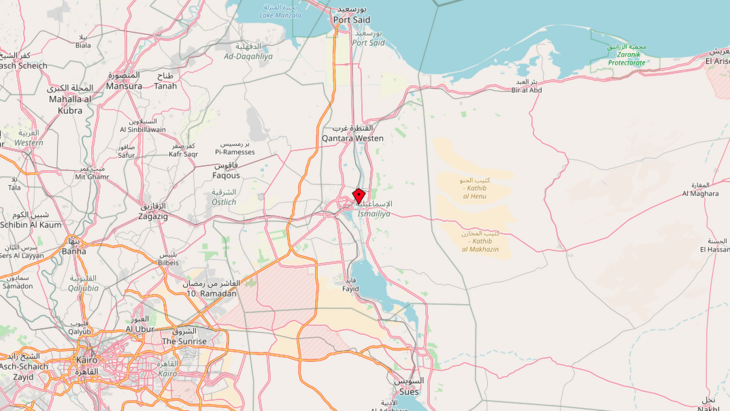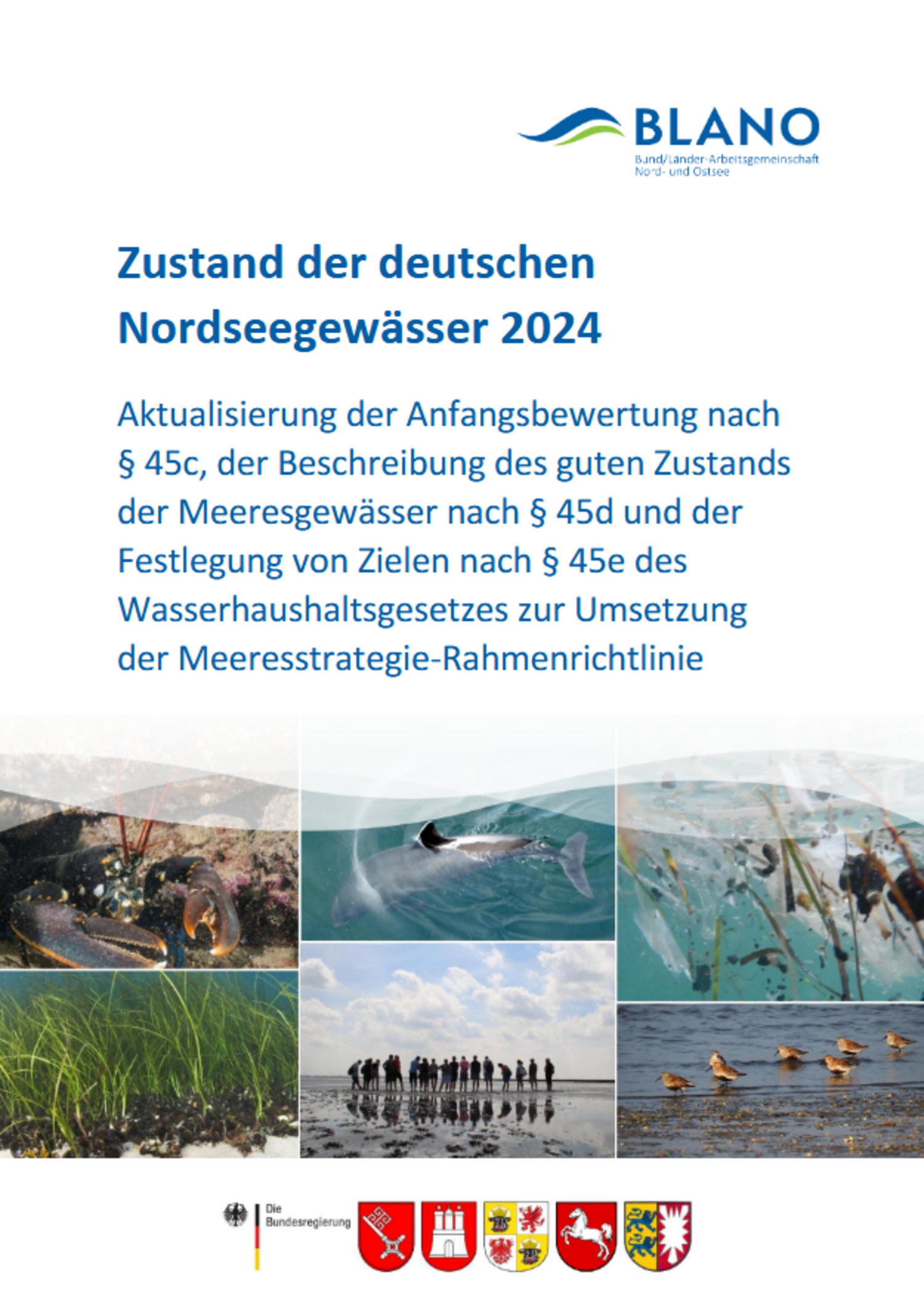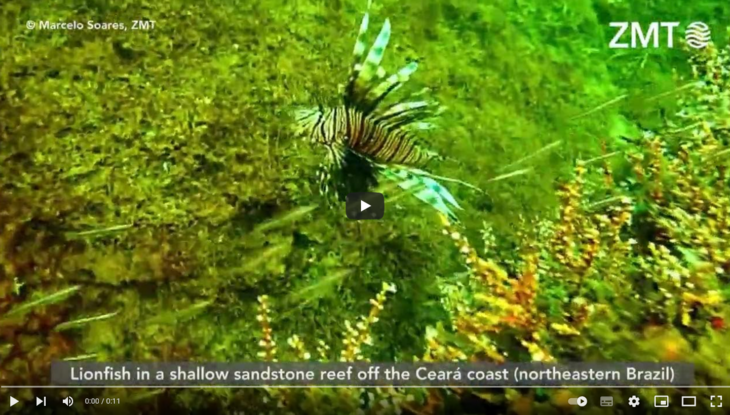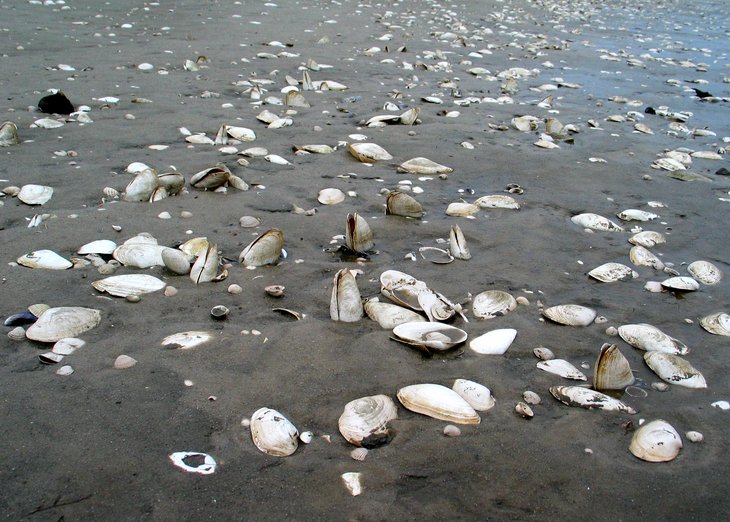
The Vikings were among the first pioneers. When ships belonging to this seafaring people returned to their home waters in the Kattegat from Greenland and North America around 800 to 1000 years ago, they had North American sand gapers (Mya arenaria) on board as live provisions. Some of these clams must have survived the long journey from the east coast of North America to the North Sea. Shortly afterwards, the sand gaper, which until then had only been found in the northwestern Atlantic, spread to the North Sea and Baltic Sea. Today, the clam, which can grow up to 15 centimeters in size, is one of the most common inhabitants of areas with sandy sea beds in both seas.
The unwanted colonisation of the North American sand gaper in the North Sea is one of many cases in which humans have enabled marine organisms to gain a foothold in foreign waters. Such immigration or introduction of non-indigenous species (neobiota) can have far-reaching consequences, as in many places the newcomers change the structure and functioning of the native communities.
1. A driver of species decline?
The Intergovernmental Science-Policy Platform on Biodiversity and Ecosystem Services (IPBES) lists non-native animal and plant species as one of the five direct drivers of global biodiversity loss. The expert panel therefore published a special report on this topic in 2023.
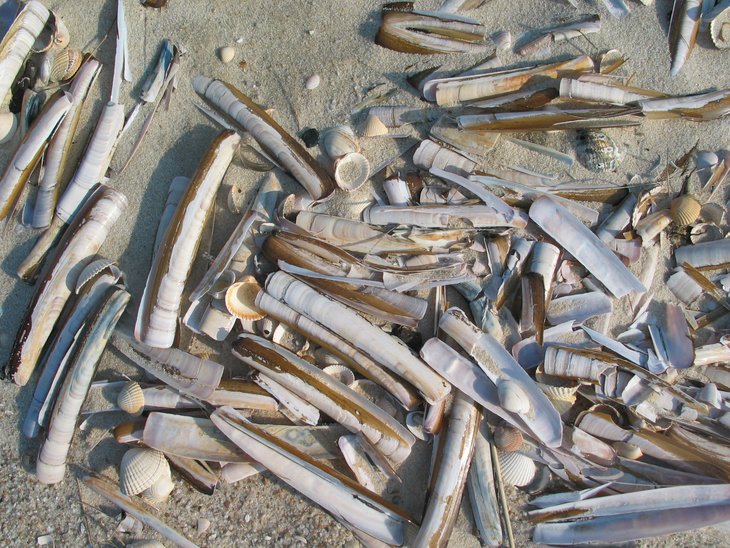
Experts are particularly concerned that the global spread of species will lead to increasing homogenisation of communities in different marine areas. The fear is that a few robust species will then be found everywhere, while specialist species will be pushed back. This could lead to a global decline in biodiversity in the long term. However, whether these concerns will one day prove to be true is a matter of controversy in the scientific community and probably depends on the habitats under consideration.
Anyone wishing to follow the debate must distinguish between non-native species and invasive non-native species. Non-native refers to organisms brought into new regions through human activity. The term invasive, however, is reserved for those that not only take root and spread in their adopted habitat but also cause damage to local ecosystems, species and biodiversity.
The proportion of invasive species can be surprisingly small. In European seas, for example, more than 800 non-native organisms are now present – but according to current knowledge, only a few pose a threat to native communities and their functions. Even so, experts urge caution: “Once introduced species have become established in marine areas, it is generally impossible to remove them completely through countermeasures. The best approach, therefore, is to prevent their introduction in the first place,” according to the 2022 report on non-native species along the German North Sea and Baltic Sea coasts.
2. The various migration routes of marine neobiota
Humans enable marine organisms, both intentionally and unintentionally, to cross the boundaries of their native ranges and migrate into new marine regions. The most important pathways of introduction include:
- Transport by ships: Tens of thousands of species are carried across the world’s oceans, either clinging to boat and ship hulls or floating in ballast water. On arrival, the organisms may detach or be released with ballast water into their new environment. To curb such unintentional transfers, the International Maritime Organization (IMO) adopted the International Convention for the Control and Management of Ships’ Ballast Water and Sediments in February 2004. It entered into force on 8 September 2017 and stipulates, among other things, that ballast water may only be discharged if certain limits or requirements are met. Nevertheless, shipping continues to contribute to the spread of species. This applies both to existing transport routes where shipping traffic is increasing and to regions where tankers and cargo ships have only recently begun to operate regularly – such as the Northeast Passage through the Arctic Ocean.
- the construction of artificial waterways that connect previously separate marine regions: In this way, former distributional boundaries are removed and migration is made possible. One example: since the opening of the Suez Canal in November 1896, more than 450 species from the Indian Ocean have migrated into the Mediterranean, including cnidarians such as the nomad jellyfish (Rhopilema nomadica), which appears in large swarms, more than 160 species of mussels, and an armada of over 100 fish species.
- Escape of non-native species from aquaculture and other breeding facilities: In the Amazon region, for example, intensive fish farming has played a major role in the establishment of 41 non-native fish species in the river and its estuary – more than half of which are predators or omnivores. Species imported for breeding also rarely arrive alone, as observations from European coastal waters show. Here, around 60 different pathogens, parasites and fouling organisms, such as tunicates, spread alongside introduced farmed mussels like the Japanese carpet shell (Ruditapes philippinarum) and the Pacific oyster (Magallana gigas).
- Intentional release of non-native species into a new habitat: In the Norwegian Barents Sea, a profitable fishery has developed after the red king crab (Paralithodes camtschaticus), originating from the North Pacific, was released there in the 1960s. With no natural predators, the large crabs have since spread along the northern Norwegian coast – to the delight of local fishers. They now catch and export king crabs worth the equivalent of 100 million euros per year.
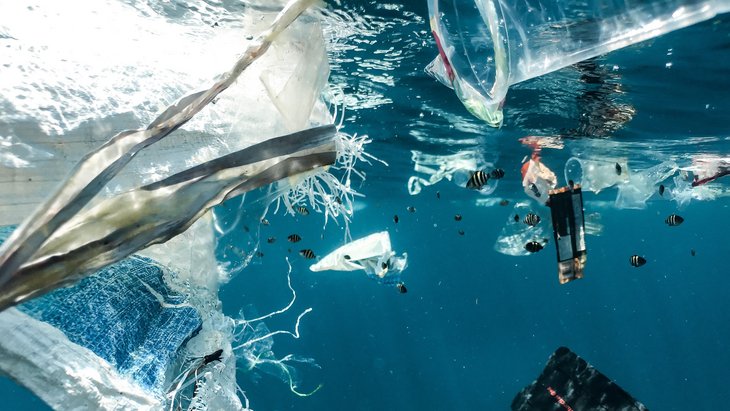
- Migration on floating debris such as plastic waste: Pacific-origin sun corals, Tubastraea coccinea and Tubastraea tagusensis, for example, also spread along the Brazilian Atlantic coast in this way. These two Pacific species possess extensive defence mechanisms, reproduce rapidly, and – due to the absence of predators in the South Atlantic – are highly capable of displacing native corals such as the large-polyp stony coral (Mussismilia harttii) from their traditional reefs.
3. How many non-native species are there in the oceans?
The first reports of the establishment of non-native marine organisms date back to the early 19th century. Since then, the number of known introduced or migrant species in the various ecosystems of the world’s oceans has been steadily increasing, partly because research on this topic has intensified since the 1970s.
In 2020, a team of scientists analysed a large number of existing datasets on non-native aquatic organisms and counted 1,442 introduced or migrant species across 39 marine and freshwater ecosystems. The newcomers were primarily organisms from the phyla of arthropods, mussels and fish, as well as red algae, annelids, tunicates, bryozoans and cnidarians.
However, the researchers assume that their statistics greatly underestimate the actual number of neobiota: firstly, because the data sets evaluated only covered 73 per cent of the most important aquatic habitats on Earth. Secondly, in many places it is not clear which species have always lived in the region and which organisms arrived when and how.
Much work therefore still awaits specialists in marine invasion research – particularly with regard to standardised methods, comparable time frames and comprehensive observations. To date, for example, there is little evidence of non-native species migrating to the open ocean or to depths of more than 200 metres. In addition, many observations have so far been limited to periods of a few decades. From this perspective, little is still known about the long-term effects of neobiota on native ecosystems and communities of organisms. This applies in particular to the long-term consequences of viruses and diseases that neobiota introduce into a new habitat. These have hardly been researched to date.
4. Checks on the German North Sea and Baltic Sea coast
The European Marine Strategy Framework Directive obliges Germany to regularly monitor the condition of its marine waters and to document and assess them using various indicators (descriptors). The number of newly recorded non-native species is one of these descriptors. For this reason, experts commissioned by the federal government and the coastal states have developed a uniform monitoring programme for non-native species. It comprises 16 stations along the North Sea and Baltic Sea coasts. At these stations, researchers regularly conduct species counts and record the presence, new introductions, spread, and population development of neobiota.
A good environmental status …
... for German North Sea waters with regard to non-native species is achieved when the introduction and introduction of new species is close to zero and when non-native species have no negative impact on populations of native species and natural habitats.
With twelve newly reported neobiota in the German North Sea (2016–2021), the introduction rate remains too high and good environmental status has not been achieved.
From the latest report by the Federal/State Working Group on the North Sea and Baltic Sea (BLANO) on the state of German North Sea waters in 2024
All data is reported to the central MARLIN Neobiota Information System, and all information regarding marine neobiota in Germany is made available on a neobiota platform. There, experts also publish information about new arrivals such as the amphipod Chelicorophium robustum, which was first detected in the coastal waters of the Baltic Sea in September 2024. This tiny creature, which can grow up to eight millimetres long, originates from the Caspian Sea and was already known to exist in the Rhine. It now appears to have settled in the first brackish water areas of the Baltic Sea.
Two years earlier, researchers summarised all the knowledge known to date about non-native species in German coastal waters in the 2022 report on neobiota on the German North Sea and Baltic Sea coasts. In it, they list 122 introduced species that have become firmly established. A further 22 neobiota appeared only temporarily or were unable to establish populations. For an additional 12 species, it was doubtful at that time, but could not be ruled out, that they had been introduced from outside.
5. The difficulties of assessment
The impact that introduced species have on local communities can often only be assessed after some time. It is quite possible for newcomers to survive in their new habitat for a while, but not reproduce there and thus not establish their own population. Others, on the other hand, quickly produce offspring and spread within a short period of time – especially if there are no natural enemies such as predators and parasites in their new home.
One of the best-known examples of invasive marine species is the red lionfish (Pterois volitans), which originates from the Indo-Pacific. In the 1980s, hobby aquarists are believed to have released a few specimens of this species into the coastal waters of Florida. The striking predatory fish then spread over the Gulf of Mexico into the Caribbean Sea within 30 years. These solitary hunters primarily inhabit coral reefs, where they prey on juvenile reef fish. Scientific experiments have shown that a single red lionfish can significantly reduce the abundance of juvenile fish in the coral reef it occupies.
Despite such examples, many experts consider it wrong to judge the introduction, establishment and subsequent spread of non-native species as inherently good or bad. These categories exist only in human perception. In nature, changes mean that some groups of organisms benefit, others may lose out, and for yet others, nothing changes.
What is crucial in the migration of non-native organisms is whether the newcomers perform similar ecological functions to native species in their new habitat, thereby maintaining the range of ecosystem services. If this is the case, the species composition may change, but the functional diversity does not.
6. Observations from the Wadden Sea
Compared to forests and meadows on land, many marine ecosystems are more open beyond their boundaries. If necessary, native marine life can avoid introduced species more easily than creatures on land. Often, native species also adapt to the immigrants. Studies from the European Wadden Sea show how such coexistence between native and introduced species can even increase the biodiversity of a marine habitat.
Researchers now know of more than 100 non-native species that have settled in the Wadden Sea. Twelve per cent of the newcomers come directly from distant marine areas. However, the majority first migrated to neighbouring regions and then made the leap to the Wadden Sea from there – often because man-made structures such as port facilities allowed the new organisms to settle.
One of the non-native species is the Chinese mitten crab (Eriocheir sinensis). It migrated at the beginning of the 20th century when ships began to use ballast water for stabilisation. Today, it is the most common crab in the rivers flowing into the Wadden Sea. However, the mitten crabs have not yet had any impact on the ecosystem of the tidal zone.
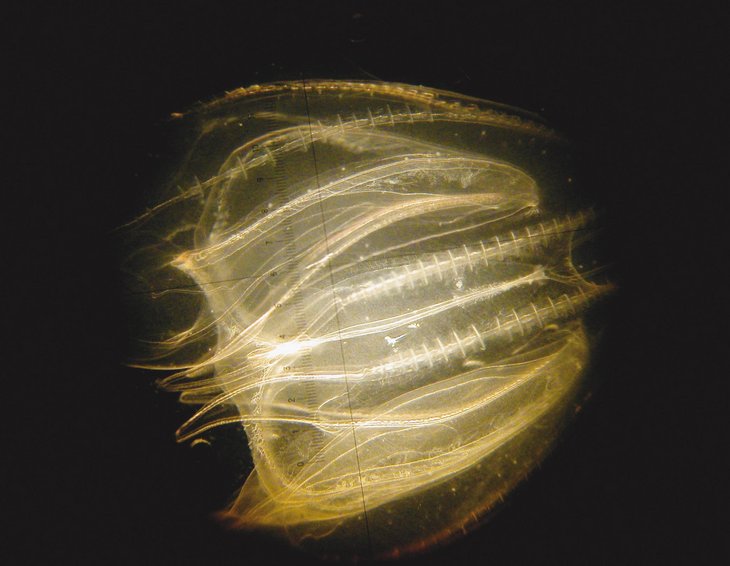
Another comparatively recent non-native species is the comb jelly (Mnemiopsis leidyi). This roughly ten-centimetre-long ctenophore was first recorded in the North Sea in 2007 and has been under observation ever since. So far, the populations appear to fluctuate strongly, particularly in response to winter temperatures. Rising water temperatures are, however, expected to facilitate the spread of the comb jelly. As it feeds on zooplankton, fish eggs and larvae, it both competes with native marine animals for food and acts as a predator in the nurseries of fish. Negative effects on the native fauna are therefore possible, but a definitive assessment of the comb jelly’s impact has yet to be made.
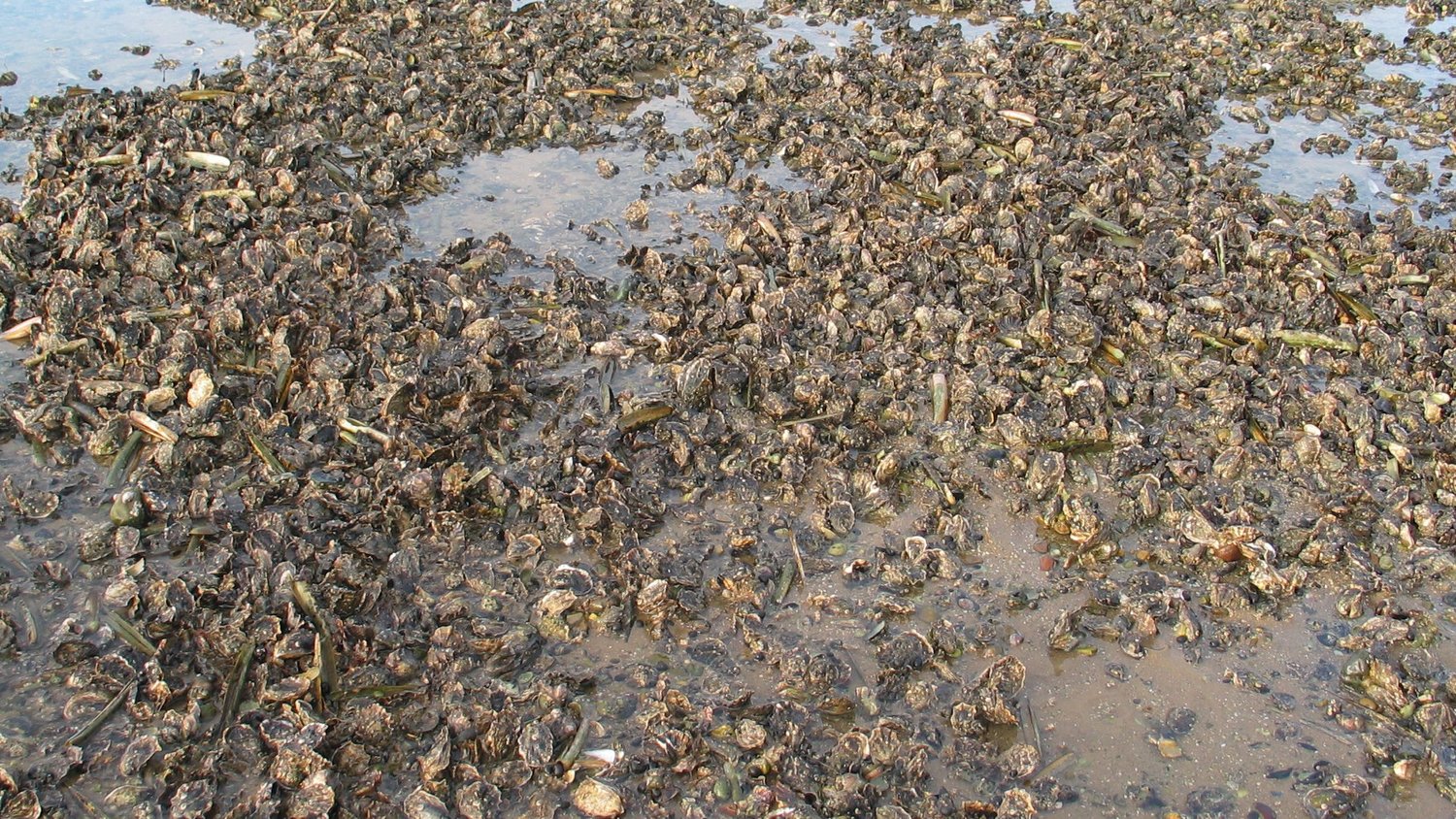
The situation is different for the Pacific oyster (Magallana gigas). This fast-growing oyster spread throughout the Wadden Sea after fishers first introduced it to oyster farms in France, the Netherlands and Great Britain. Since 1986, it has also been kept in net bags as an aquaculture organism off the island of Sylt, directly in the Wadden Sea. The oyster larvae only settle on solid ground. They found this in the Wadden Sea on the native mussel beds. The young animals settled on the shells of the mussels and quickly overgrew the mussel beds they had formed.
What initially looked like a hostile takeover followed by displacement turned out to be a useful coexistence over the next 20 years. The oysters began to grow only on top of each other and no longer used the mussels as a hard substrate. They quickly formed a new upper layer on the mussel bed.
The mussels settled on the much muddier layer below. Although they now have less space than before and compete with the oysters for food, the top layer of oysters offers them protection from predators such as the common shore crab and other organisms that are harmful to mussels and attach themselves to the mussel shells, such as barnacles.
As a result, there are now many more organisms living in the same area, although not all mussel beds are colonised by oysters. Another advantage is that oyster beds appear to be so robust and stable that they survive severe storms much better than mussel beds alone.
It is not yet clear whether the protective layer of oysters also means that typical mussel hunters such as oystercatchers find less food in the Wadden Sea. These striking seabirds suffer much more from the increasing number of rats, foxes and raccoon dogs in the coastal area. These predators particularly like to plunder the nests of oystercatchers, which breed on the ground.
- Bailey, S. A., et al. (2020): Trends in the detection of aquatic non-indigenous species across global marine, estuarine and freshwater ecosystems: A 50-year perspective. Diversity and Distributions, 26(12), 1780–1797. doi. org/10.1111/ddi.13167
- Bundesministerium für Umwelt, Naturschutz, nukleare Sicherheit und Verbraucherschutz (BMUV) (Hrsg.) (2024): Zustand der deutschen Nordseegewässer 2024. Aktualisierung der Anfangsbewertung nach § 45c, der Beschreibung des guten Zustands der Meeresgewässer nach § 45d und der Festlegung von Zielen nach § 45e des Wasserhaushaltsgesetzes zur Umsetzung der Meeresstrategie-Rahmenrichtlinie. Bund/Länder-Arbeitsgemeinschaft Nord- und Ostsee (BLANO), 15. Oktober 2024.
- Carlton, J.T., Schwindt, E. (2024): The assessment of marine bioinvasion diversity and history. Biol Invasions 26, 237–298 (2024). doi.org/10.1007/s10530-023-03172-7
- De-IPBES (2023): Kernaussagen aus der Zusammenfassung für die politische Entscheidungsfindung (SPM) – Thematisches IPBES Assessment zu Invasiven gebietsfremden Arten und ihrer Kontrolle, www.de-ipbes.de/files/IPBES_IAS_SPM_Uebersetzung_Kernaussagen.pdf
- Essink, K. & Oost, A.P. (2019): How did Mya arenaria (Mollusca; Bivalvia) repopulate European waters in mediaeval times?. Marine Biodiversity 49, 1–10 (2019). https://doi.org/10.1007/s12526-017-0816-y
- IPBES (2023): Thematic Assessment Report on Invasive Alien Species and their Control of the Intergovernmental Science-Policy Platform on Biodiversity and Ecosystem Services. Roy, H. E., Pauchard, A., Stoett, P., and Renard Truong, T. (eds.). IPBES secretariat, Bonn, Germany. doi.org/10.5281/zenodo.7430682
- Lackschewitz, D., Reise, K., Buschbaum, C., Karez, R. (2022): Neobiota der deutschen Nord- und Ostseeküste. Eingeschleppte Arten in deutschen Küstengewässern. LLUR SH-Gewässer (394 Seiten)
- Reise, K., C. Buschbaum, H. Büttiger, Wegner, K. M. (2017): Invading oysters and native mussels: from hostile takeover to compatible bedfellows. Ecosphere 8(9):e01949. doi.org/10.1002/ecs2.1949
- Reise, K., Buschbaum, C., Lackschewitz, D. et al. (2023): Introduced species in a tidal ecosystem of mud and sand: curse or blessing? Marine Biodiversity 53, 5 (2023). doi.org/10.1007/s12526-022-01302-3
- Strasser, M. (1998): Mya arenaria — an ancient invader of the North Sea coast. Helgolander Meeresunters 52, 309–324 (1998). https://doi.org/10.1007/BF02908905



